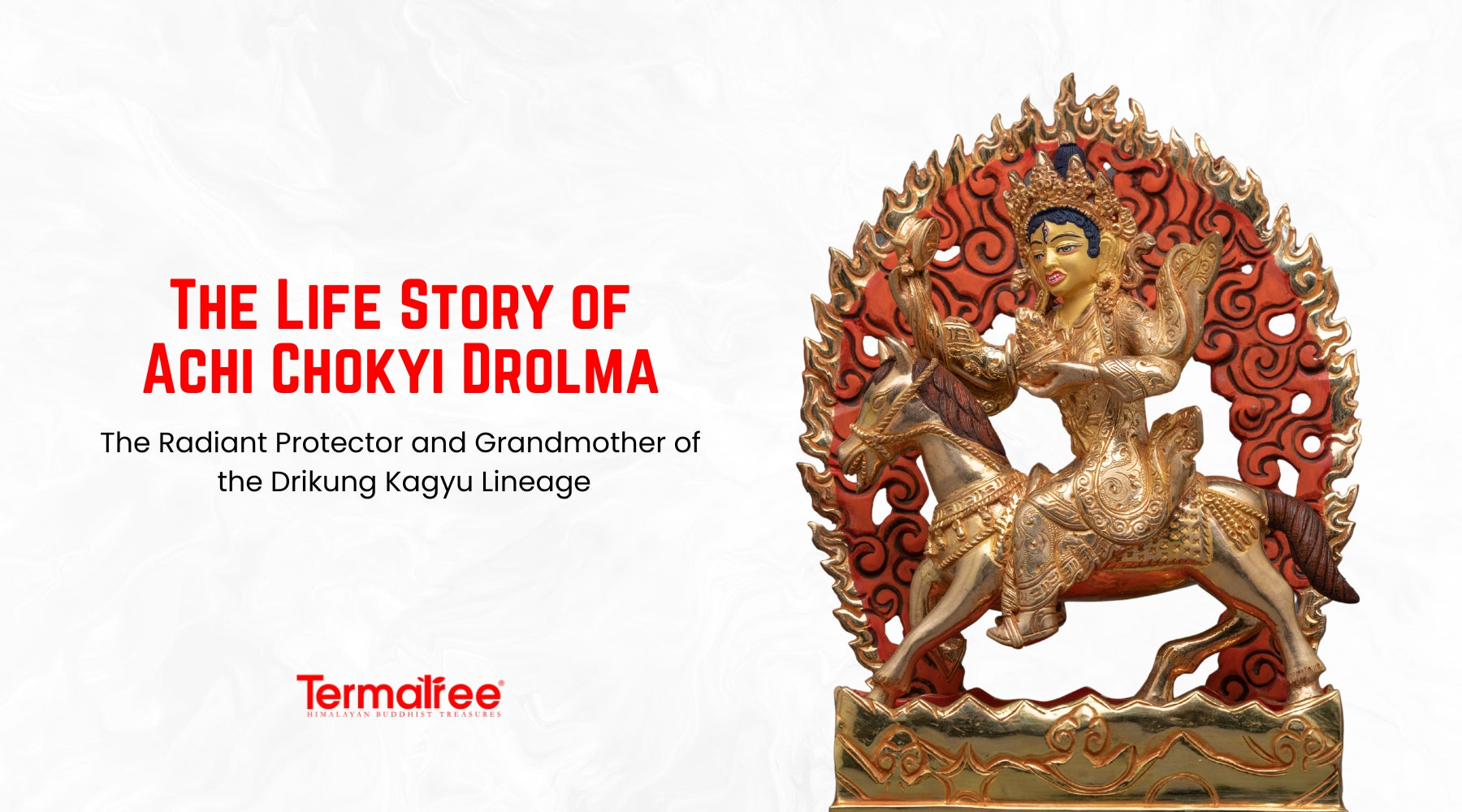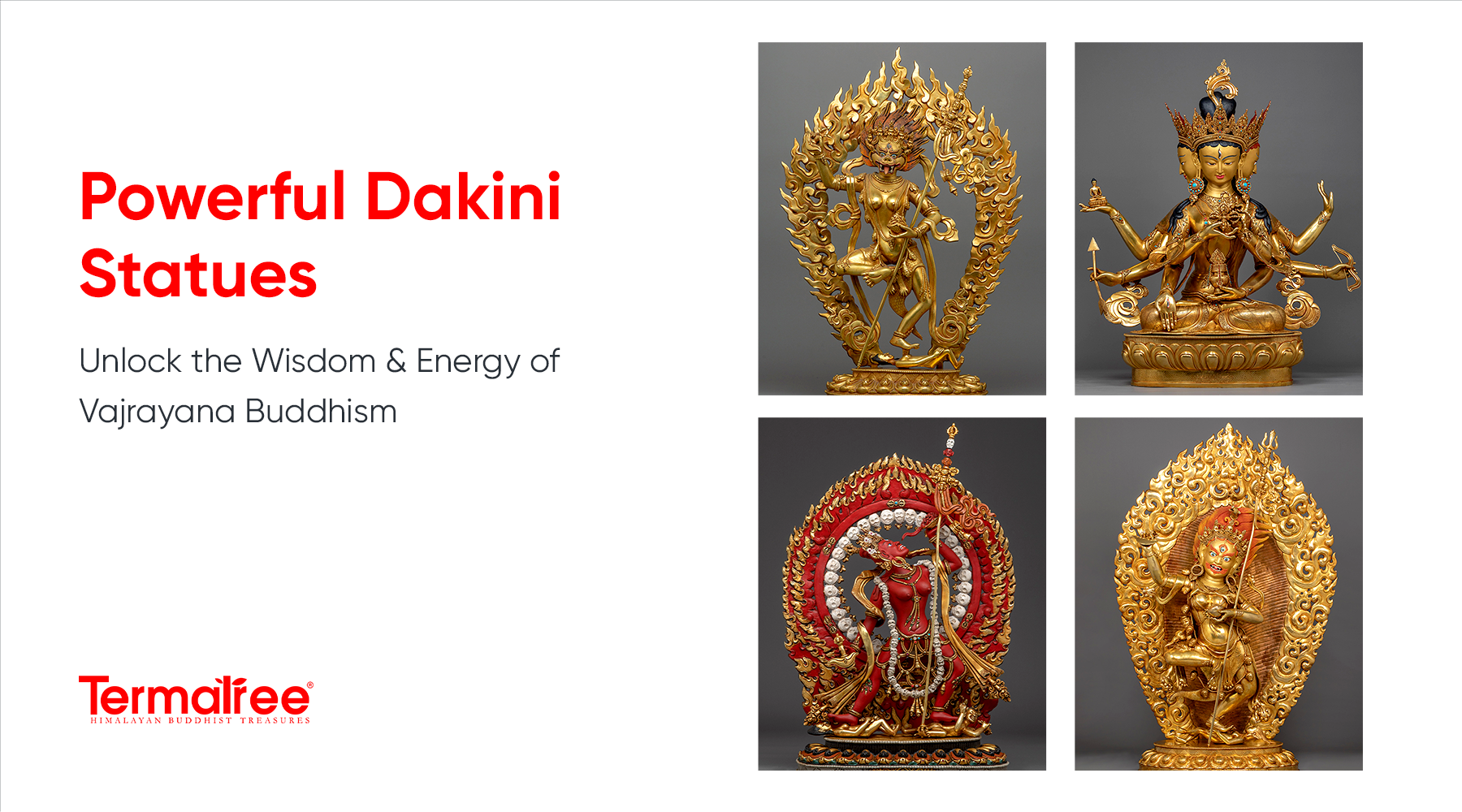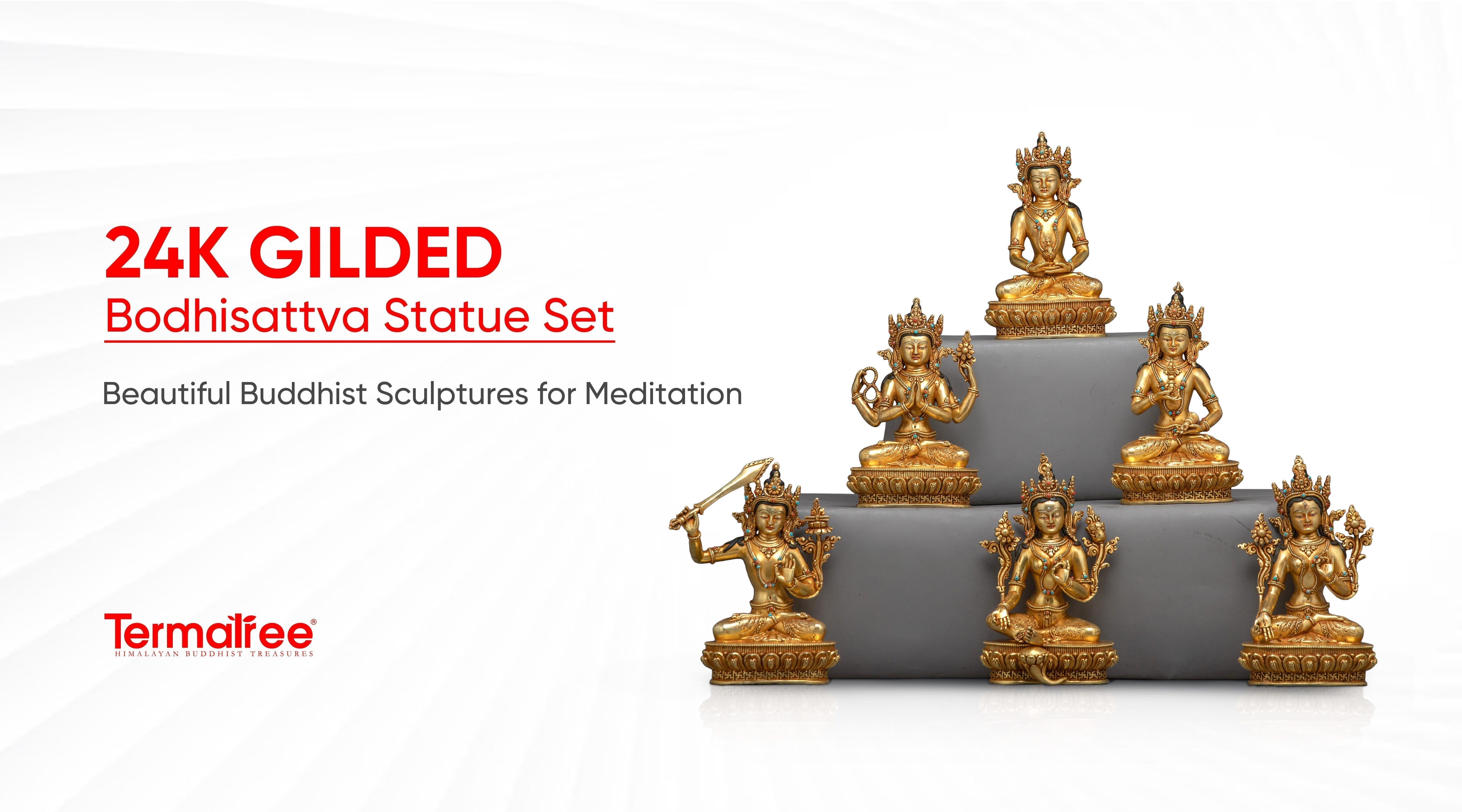The Miraculous Life and Legacy of Achi Chokyi Drolma in Tibetan Buddhism
Achi Chokyi Drolma is the fully enlightened female protector of the Drikung Kagyu tradition; she embodies the perfect manifestation of wisdom and compassion. As a fully enlightened dakini, she transcends the usual categories of guardian deities known in Tibetan Buddhism. Achi is more than a celestial being called upon for protection; she lived as a human being with miraculous abilities, as a mother, a yogini, and a teacher. Her life story demonstrates that enlightenment is not limited to a specific gender or according to worldly concerns: it can be lived out completely, inhabiting the rhythms of human experience.
She is primarily known for her miraculous birth, her capacity for clairvoyance, her unbreakable promise to protect the Dharma and its followers from one time to the next, and her strong connection to the Drikung Kagyu lineage. Achi Chokyi Drolma is more than a figure of legend; she is still a living reality in the Drikung Kagyu tradition in the form of a compassionate grandmother who hears the cries of those who need protection and responds almost immediately. In this blog, we take a deep dive into her life story, prophecies, and practices, and her importance in modern spiritual life.
A Divine Origin: The Miraculous Birth of Achi Chokyi Drolma

In the 11th century in Shotoe, Tibet, near Drigung, a couple was unable to conceive and went on a pilgrimage to Swayambhunath in Nepal to pray for a child. During the night, the wife, Driza Darzam, dreamt of a blazing sun rising in the east and filling the entire universe with light, especially illuminating her own homeland. That same night, her husband, Nanam Chowopal, dreamt of a rosary of clear white light descending from the Eastern Buddhafield into his wife's womb.
In the morning, upon waking, they shared their dreams. Nanam Said, “A special child will be born to us, and we must take care.” After praying heartily and providing tsok, they returned to Drigung. When the time came to deliver, an extraordinary daughter was born in Kyetrag Thang with many auspicious signs. Her pure white body radiated light, and by the time she was three years old, she was teaching mantras. She rapidly matured, was extraordinarily beautiful, and after her parents passed, she went to live with her uncle.
Her Life as a Yogini: Devotion and Realization
Marriage and Union with a Yogi
Many had approached Achi Chokyi Drolma to marry her, and she refused them all, saying, "I will go to Kham in eastern Tibet. There lives a great yogi from the distinguished Kyura clan. This Yogi, I will marry. Our daughters and sons, and grandsons will be extraordinary beings who will be of benefit to all sentient beings, spreading the essence of the Buddha's teachings." Having this prophetic certainty, she traveled to the east with a merchant to Kham.
When she arrived at a place called Dentod Tsongur, she told her merchant companion, "This is a place I can stay." She then went to the great saint Ame Tsulrim Gyatso, saying, "Although I have no attachment to worldly life, if we combine teachings then among our offspring, there will be famous enlightened beings who will accomplish the great benefit of the teachings of the Buddhas." On the day of their combining, although he had no way to arrange a professional ceremony, Achi told him, "Don't worry, I will do it." As Achi miraculously pulled a damaru out of her right pocket and a kapala from her left pocket. Pounding the damaru and holding the kapala, she began sky-gazing dancing. Instantly, their house was filled with rich garments, abundant food, and drink, delighting all the guests.
Activities and Sacred Offerings
Achi and Ame Tsultrim Gyatso had lived together and given birth to four sons (Namkhe Wangchuk, Pekar Wangyal, Sonam Pal, and Kathung Trushi). Each son was brilliant and succeeded as a great scholar in worldly and spiritual matters. Achi's bloodline thus became the basis of an unbroken "spiritual bloodline."
Later, Achi declared, "I have taken birth into samsara knowingly with the intention of fulfilling my aspirations to protect the teachings of the Buddha, and with the welfare of all sentient beings in mind. For this reason, I will grant ordinary experiences of siddhi and supreme experiences of siddhi to my followers." She took her disciples to the blessed cave of Ting-ring and found many naturally arisen statues and carvings of Buddhas, Bodhisattvas, yidams, dakinis, and Dharma protectors. She transformed the human corpse into a great tsok and gave ordinary and supreme siddhi to the participants.
She then wrote a sadhana and vowed to protect the teachings of the Buddha, especially those not yet arisen. Proclaiming, “My activities through this body have come to an end,” Achi rose bodily into the sky on her blue horse, without leaving a corpse, completing her vow to be the undying protector of the Dharma.
The Prophecy of Kyobpa Jigten Sumgon
Achi's greatest legacy of all was the bloodline that eventually produced Kyobpa Jigten Sumgon, one of the most important figures in Tibetan Buddhism. Achi, before the birth of Kyobpa Jigten Sumgon, prophesied his birth and made it her responsibility to ensure that conditions would bring him to a successful arrival. This divine foresight established Achi as not just a protector, but as a matriarchal foundation of an entire lineage.
She was a visionary and knew how to make karmic causes that would lead to the success of her future child. She gave all her children spiritual instruction and blessed the places they lived. Her faith in the Dharma, and for future generations, was resolute.
Iconography of Achi Chokyi Drolma

Serene Yet Dynamic Appearance
-
Achi Chokyi Drolma is shown as a dignified, mature female figure, an influential yet calm female figure.
-
Her presence is regal and serene with the quality of maternal love, instead of a wrathful fierceness.
-
In her most emblematic form, she is riding through the air on a blue horse and is there to protect dharma practitioners, demonstrating that she transcends the ordinary limitations of space and time, while still compassionately engaging with the human realm.
-
In all representations of her, she maintains a calm yet resolute expression and presents herself as both a peaceful dakini and a fierce protector.
Attributes and Ornaments
-
In one hand, Achi holds a mirror, symbolizing her insight into the ultimate reality of existence and the ability to dispel delusion.
-
On the other hand, Achi holds a kapala (skull cup), which ultimately represents her power of transforming a lack of ego and ignorance into wisdom.
-
Achi wears the stylistically traditional silk clothing of the Tibetans, as well as bone ornaments, and a billowing celestial silk scarf that suggests beauty as well as both worldly and spiritual power.
-
The clothing represents mastery of the six perfections and realization of the tantric Vajrayana path.
-
In thangka representations of Achi, she is also depicted wearing a five-skull crown representing her feeling of transcending the five poisons (kleshas).
The Turquoise-Blue Steed: Symbol of Swift Liberation
-
Achi's blue steed is an integral part of her symbolism. The blue horse is the representation of the element of wind and speed in an esoteric sense.
-
The color blue signifies unobstructed movement, while the horse is a surrogate for the lungta (wind horse), which conveys vitality and good luck.
-
In depictions, the horse may appear to be galloping on clouds, lotus blossoms or patterns of wind, supporting Achi's transcendental imagery.
-
The horse may also be shown blowing fire or with effulgent hooves, suggesting her far-reaching nature and ability to access distinct realms.
Symbolic Variations Across Art Traditions
-
While her general image remains consistent, some thangkas depict her with multiple arms, each holding ritual implements like damaru, phurba, or jewels.
-
In other examples, she is shown in the company of wrathful dakinis or protector deities, demonstrating her powerful presence in the Buddhist celestial realms.
-
The images depicted on the paintings clearly illustrate these types of symbolic elements, which reinforce her active and fearless compassion.
-
As images of her thangkas, these may serve both meditative and instructional purposes – aspects of her enlightened qualities, and help with a visualization practice.
Achi in Practice: Sadhana, Mantra, and Ritual
The Sadhana of Achi
Achi Chokyi Drolma's practice has gained popularity with both monastics and lay practitioners alike. Her sadhana, or spiritual practice text, has been passed down through the lineage of great masters of the Drikung Kagyu. When practitioners visualize Achi Chokyi Drolma, they call for Achi's presence with the intention of the practitioner receiving her protection and blessings. The practitioner performs offerings, recites mantras, and makes the visualization as a means to connect with Achi's enlightened state of being.
The Mantra of Achi Chokyi Drolma
Her mantra is:
OM SARVA BUDDHA DAKINI HRI MAMA TSAKTRA SOHA
This magical formula invokes her power familiar to practitioners to dispel obstacles, protect from harm, and incentivize spiritual potentialities. The mantra is also recited at times of imminent danger and spiritual discursion, or during essential activities.
Ritual Practices and Feast Offerings
Achi's practice also includes tsok (feast offering), a sacred gathering for practitioners to honour her offering food, drink, and mantra. These offerings generate merit and provide a good tapestry (karmic harmony) amongst participants at such gatherings. Practitioners believe Achi's presence is powerful at this moment.
Achi in the Modern World
Achi Chokyi Drolma continues to enjoy significant popularity within the modern spiritual world. She is commonly invoked during daily practices and protective ceremonies, and even within prayers for worldly peace. Many of the organizations that are connected with the Drikung Kagyu lineage also remember her practice as part of the core curriculum for their centers.
The 8th Garchen Rinpoche explained that Achi's practice is especially relevant for modern practitioners since she is more approachable and more contemporary, but even more so as a bridge between worldly matters and ultimate realization. He frequently describes Achi as being the very essence of grandmotherly love—compassionate, direct, and safeguarding.
Praise by Jigten Sumgon
Kyobpa Jigten Sumgon, Achi Chokyi Drolma's divine successor, wrote some of the most profound praises to Achi Chokyi Drolma. His praise recognizes her as the Dakinis' Queen and the mother of liberation, as well as the protector of the Dharma in unwavering matter. One of the most classic lines of his prayer provides:
"To you, the great protector, who flies through the sky on a turquoise dragon horse— I bow in devotion, Mother Achi."
This prayer continues to be recited today in the Drikung Kagyu monasteries, creating an unbroken line from lineage founder to its eternal protector.
Historical Texts and Terma Revelations
Achi's biography exists in many forms: orally transmitted accounts, scriptural biographies, and treasure texts (terma) revealed by tertöns. The most detailed accounts of Achi and her life come from the writings of lineage masters in the Drikung tradition and modern scholars. These historical texts affirm her spiritual achievement and provide rich accounts of her religious practice, her family life, and her unwavering commitment to the Dharma, as well as the oral lineage of her story, one continued by generations of master practitioners. As a living tradition, her life story is not just some distant myth or past event, but one that becomes available to attentive practitioners who follow the teachings and practices passed down to them.
In particular, the treasure texts highlight Achi's dakini role beyond the confines of a single lineage. While she is closely associated with the Drikung Kagyu, in treasure texts she is referred to as a dakini and enlightened being whose protective influence and power extend to all of Vajrayana's traditions. They position her in the larger mandala of wisdom dakinis and protectors - the embodiment of the enlightened feminine principle, who act as per the most sincere aspirations of bodhicitta. As such, she embodies not only the protector of a lineage but also the enlightened potential we all share.
Legacy and Living Transmission

Achi Chokyi Drolma is more than a historical figure; she is a living part of the Drikung Kagyu lineage. Her practices are continuing through authentic lineages, with ritual manuals, visualizations, and oral commentaries still formally taught and performed all over the Tibetan Buddhist world. In both monastic and lay settings, her sadhanas are regularly performed in order to request protection, healing, and spiritual clarity.
Many high lamas currently living, including His Holiness Drikung Kyabgon Chetsang and Garchen Rinpoche, think of her as one of the most essential and accessible protectors for practitioners of today. Her iconography and teachings are a powerful bridge between ancient tantric knowledge and the needs of present-day seekers. By generating honest devotion and by reciting her mantra with utmost sincerity, practitioners cultivate not just outer protection but inner qualities of strength, compassion, and spiritual resilience; qualities which are a reflection of Achi's continuing blessing and enlightened activity.
Conclusion: Achi Chokyi Drolma, Mother of All Lineages
The biography of Achi Chokyi Drolma is a remarkable tale of kindness, wisdom, and cosmic responsibility. From the miraculous story of her birth and her yogini life, to her passing on and compassionate presence, she embodies all enlightened activity. She is more than a protective deity that we invoke during ritual Weave; she is an actual living being - a mother, a loving grandmother, and a radiating dakini, shining radiance on the pathway of awakening. She is a real, living embodiment of feminine wisdom and action, a completer of devotion and spiritual love with a fearless and total commitment to cultivating the happiness of all sentient beings.
As we continuously grapple with our distractedness, Achi Chokyi Drolma allows practitioners immediate access to spiritual clarity, emotional strength, and unmovable protection. Achi Chokyi Drolma reminds current practitioners to sustain their struggles with their ethical behavior as they pursue realization while giving them strength, but not aggression, and wisdom, but without indifference. Achi Chokyi Drolma's legacy has been enormously important now as it was one thousand years ago, forever guiding, forever protecting, and forever available to all beings who genuinely and accurately want to communicate her name.




